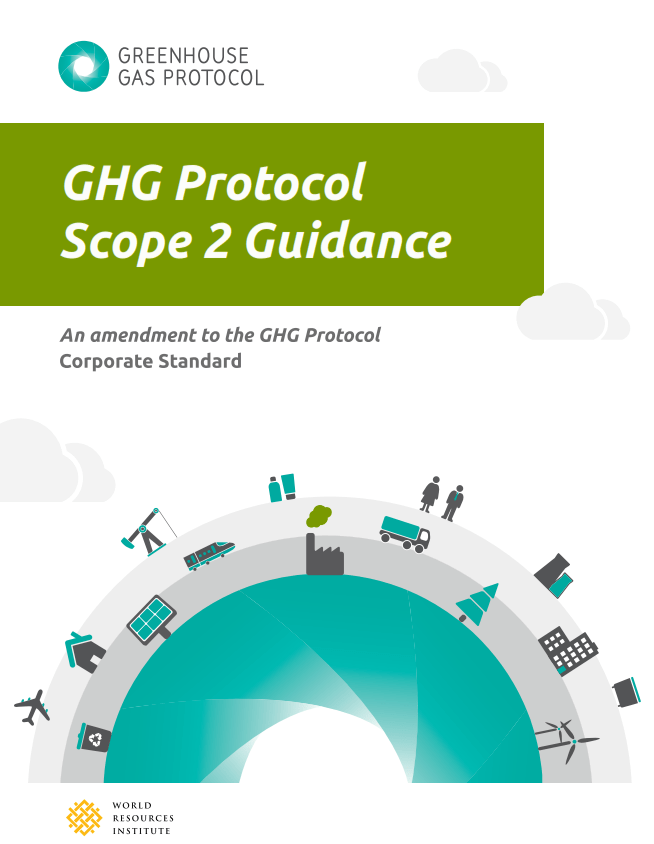GHG Protocol Scope 2 Guidance
Bringing Greater Transparency and Clarity to Market-Based Calculations

The adage “What gets measured gets managed” is never more true than when applied to greenhouse gas (GHG) accounting. Yet, with ever-evolving technologies and regulations, it is critical that measurement is done consistently and accurately. The GHG Protocol’s Scope 2 Guidance is an indispensable asset on that front.
The GHG Protocol, a partnership between the World Resources Institute and the World Business Council for Sustainable Development, encountered this issue a few years after it developed the Corporate Standard. The Corporate Standard offers users detailed instructions and suggestions on identifying and calculating emissions as well as identifying corporate boundaries, undergoing verification, and many other aspects involved in the development of a corporate GHG inventory. However, as a growing number of companies started purchasing electricity from sources other than the local utility such as renewable energy certificates (RECs), power purchase agreements (PPAs), and guarantee of origin (GO), it became apparent that the authors of the Corporate Standard had not anticipated the various ways in which companies would account for these sources. As a result, companies began accounting for these clean and renewable energy purchases inconsistently. Not only did this prevent apples-to-apples comparison of performance across companies, it called into question the accuracy and transparency of reported GHG emissions.
On January 20, 2015, the GHG Protocol released Scope 2 Guidance: an Amendment to the GHG Protocol Corporate Standard to mitigate these issues and provide companies the opportunity to demonstrate emissions reductions through electricity procurement decisions. Likewise, the amendment offers guidance on topics such as how to factor in the uncertainty associated with emissions reduction initiatives when the energy source has a high emissions intensity.
Scope 2 Guidance Overview
The new Scope 2 guidance provides a number of benefits:
- Increased accuracy in Scope 2 emissions reporting
- Clear and consistent methodology to account for clean and renewable energy purchases and supplier-specific data in GHG inventories
- Protocols for organizations to demonstrate electricity procurement strategy to reduce emissions
- Improved metrics for consistently measuring emissions across companies (allowing for comparison)
- Clear instructions on how all companies should report specific energy sources
- Methods for companies to differentiate between a change in consumer choices (renewable energy) and a change in emissions intensity
- Incentivized investment in low-carbon energy
- Outlines opportunities to decrease emissions through strategic energy procurement
- Redirects the market to meet the demand for low-carbon energy (note that as the demand for low-carbon energy increases, the market will need to increase supply)
Updated Reporting Frameworks
The uncertainties addressed in the new Scope 2 guidance have also been incorporated into reporting frameworks such as CDP, which now requests respondents to report both location-based and market-based Scope 2 GHG emissions totals into their annual Climate Change Information Requests. Similar to the previous methodology, the location-based method continues to allow companies to calculate emissions using the average emissions intensity of the affected grid region. On the other hand, the updated market-based method is more intricate, requiring companies to calculate emissions using a supplier-specific or contract-specific emissions intensity factor.
To ensure that users consistently apply the information outlined in the new Scope 2 guidance, the document delineates Quality Criteria for the supplier-specific emissions factor used in market-based calculations. These criteria include stipulations that the contractual instruments must “convey the direct GHG emission rate attributed with the unit of electricity produced” and must also “be tracked and redeemed, retired, or canceled by or on behalf of the reporting entity” (p. 5). These Quality Criteria ensure that the emissions are accurately and consistently reported to inform a company’s energy procurement decisions.
It is important to note that, while the Scope 2 guidance encourages dual reporting, it does allow users to track their GHG performance according to one method. For example, a company may track emissions performance using location-based Scope 2 totals to avoid having to establish a new emissions baseline. (It may, however, be best for the company to establish a new baseline and consider setting a new emissions reduction target.)
Though the new methodology requires a greater data collection effort and more detailed calculations, it has increased transparency, accuracy, and comparability. Ultimately, this will enable responding parties to improve their own operations and feel more confident in the feedback from their GHG reporting measurements as well as identify new opportunities to reduce emissions.